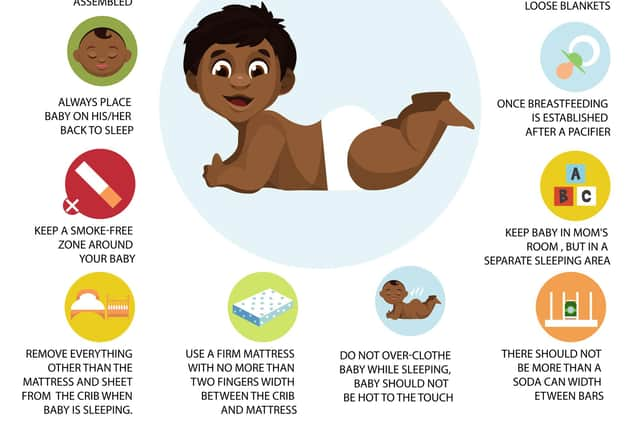Determined to understand the causes behind SIDS


Since the launch of the Back to Sleep Campaign in 1991, the number of SIDS deaths has fallen by over 80 per cent. Despite this, SIDS continues to be the primary cause of infant death in developed countries.
The death of a child has a life-long effect on both parents and siblings, and the medical community alongside with researchers and bereaved parents’ organisations, such as The Lullaby Trust, are determined to understand the causes and help reduce it.
Advertisement
Hide AdAdvertisement
Hide AdIn the past, SIDS has also been known as “crib”, “cot” or “unascertained” death, and was automatically assumed to be the result of being “overlaid” or “infanticide”. It has a reference in the Old Testament; “And this woman’s child died in the night; because she overlaid it”. “Accidental smothering” continued to be a church issue throughout the medieval period and much of the Renaissance.


By the early 19th century, infanticide had transitioned from the religious court system to judicial courts, and the 1887 Coroners Act required the coroner to differentiate between natural and unnatural deaths. In 1892, Dr Charles Templeman read his experience before the Medico-Chirurgical Society of Edinburgh on the death investigation of 399 cases. These cases consisted of infants who had died from “overlying” after being found dead whilst in bed with their parents. According to the census of 1891, the local population was 153,587, of whom more than two-thirds occupied houses with one or two rooms. Cases of overlaying reported by Templeman were almost entirely confined to this class, and the majority of cases had occurred in single-room houses. In his publication in the Edinburgh Medical Journal in 1893, he stated that “the only safeguard to its occurrence is that the child should be made to occupy a separate cot from its parents or nurse”. Still today, socioeconomic deprivation and co-sleeping continue to be significant factors.
Dr W.H. Davidson was a British pathologist who in 1942 began to publish work suggesting natural causes of death behind SIDS. However, it was not until the early 60s when Senator Dore in Seattle lost a child to "crib death" that research investigating why apparently healthy babies died of SIDS gained momentum.
Since the late 1950s, Sheffield has been internationally renowned for investigation of SIDS and engagement with bereaved families. Professor John Emery was the first consultant paediatric pathologist at Sheffield Children’s Hospital. His contributions to the understanding of SIDS began in 1956, and he was a prolific author on the topic. Furthermore, Professor Emery was key to the creation of the Care of the Next Infant at Sheffield Children’s Hospital, developing it into a national programme to help families in following pregnancies after having lost a child to SIDS; he pioneered the programme of Sheffield “health visitors” and identified features now regarded as risk factors.
Advertisement
Hide AdAdvertisement
Hide AdSIDS usually occurs during sleep, in babies who have apparently been previously healthy or suffering only a minor cold, in winter and more frequently in four to six month old male infants. Risk factors include: prone sleeping (face down), co-sleeping with an adult, smoking during pregnancy and/or in the household, family history of SIDS, hyperthermia (too many blankets and/or high room temperature), social deprivation and maternal mental health issues.
The future investigation of SIDs relies on improving training and education of families to prevent it, supporting families who have lost children, improving the investigation of individual deaths and promoting, funding and facilitating more research. In future, all sudden infant deaths will be investigated using special analysis into DNA and genes. This will be crucial to help with the scientific understanding of all the factors to further reduce these tragic deaths.